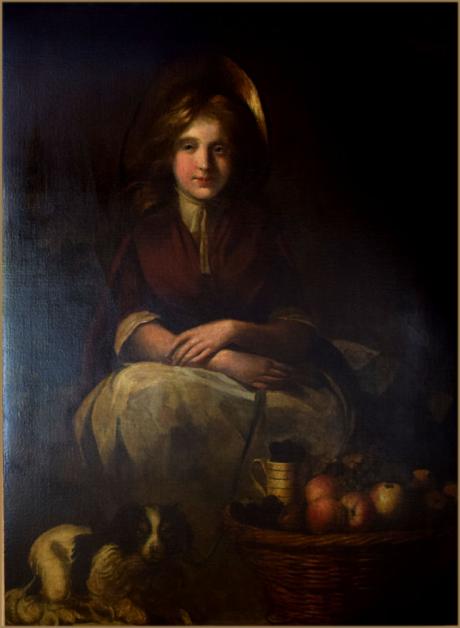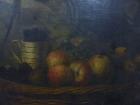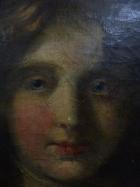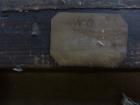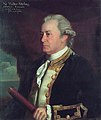Mrs. McLure-Williams
Christies Lot: 130, 7th December 1945 £12.12.0 [12gns] bt Munday
Sotheby's 3 July 1946 lot 121.
Engraved by Thomas Gaugain, 1785 "Petite Fruitiere Anglaise"
According to Jacob Simon from the National Portrait Gallery this painting is almost certainly no 202 in his edition of Jmes Northcotes account book (there was a further painting of this title, 730 in the account book). 202 was signed and dated 1785 and engraved in stipple by Thomas Gaugain that year. It appeared at Sotheby's 3 July 1946 lot 121
James Northcote RA (22 October 1746 – 13 July 1831) was a British painter. He became a member of the Royal Academy in 1787, and a member of the Royal Institute of the Netherlands in 1809.

Northcote was born in Plymouth, and was apprenticed to his father, Samuel Northcote, a watchmaker. In his spare time, he drew and painted. In 1769 he left his father's work and set up as a portrait painter. Four years later he went to London and was admitted as a pupil into the studio and house of Sir Joshua Reynolds. At the same time he attended the Royal Academy Schools.
In May 1776, he left Reynolds' studio, and about two years later, having made some money by portrait painting back in Devon, he went to study in Italy. On his return to England, three years later, he revisited his native county, then settled in London, where John Opie and Henry Fuseli were his rivals. He was elected associate of the Academy in 1786, and full academician in the following spring. The Young Princes Murdered in the Tower, his first important work on a historical subject, dates from 1786, and it was followed by the Burial of the Princes in the Tower. Both paintings, along with seven others, were intended for Boydell's Shakespeare Gallery. His enormous Death of Wat Tyler was exhibited in 1787; commissioned by a London alderman, it hung in the Guildhall until its destruction during the Second World War.
Shortly afterwards Northcote began a set of ten subjects, entitled "The Modest Girl and the Wanton", which were completed and engraved in 1796. Among the productions of Northcote's later years are the Entombment and the Agony in the Garden, besides many portraits, and several animal subjects, such as Leopards, Dog and Heron, and Lion; these were more successful than the artist's attempts at more elevated subjects, as was indicated by Fuseli's caustic remark on examining the Angel opposing Balaam —"Northcote, you are an angel at an ass, but an ass at an angel." Northcote's works number about 2000, and he made a fortune of £40,000.
He was elected to the Royal Academy in 1787. He became a corresponding member, living abroad, of the Royal Institute of the Netherlands in 1809. His Portrait of Marc Isambard Brunel was exhibited at the Royal Academy's Summer Exhibition in 1814 and is now in the National Portrait Gallery. He sponsored the admission in 1829 of Thomas Sewell Robins to the Royal Academy Schools.
In 1841, a monument to Northcote by Francis Chantrey was erected in Exeter Cathedral.
-
The Wanton Reveling with her companions, 1796
-
One of Northcote's illustrations to Shakespeare's Richard III
-
A portrait of Walter Stirling by James Northcote
-
Memorial in Exeter Cathedral by Francis Chantrey

